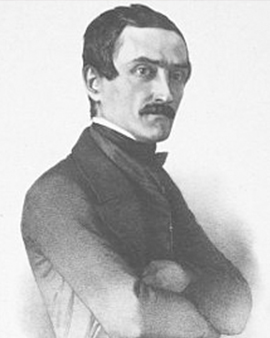Alexandre Calame, born May 28, 1810, in Arabie, a hamlet of the commune of Corsier-sur-Vevey, now part of Vevey, and died March 19, 1864, in Menton, was an outstanding painter of Switzerland. The son of a marble worker, Calame entered the world of finance at the age of 15 and took a job in a banking business. But during his free hours, his artistic talent awakened. He began to hone his drawing skills and colored small scenes of his native Switzerland. In 1829, his patron, the banker Diodati, allowed him to take lessons from the renowned landscape painter François Diday. Just a few months later, Calame decided to end his career in banking and devote himself entirely to the world of art.
Beginning in 1835, he exhibited his landscape paintings of the Swiss Alps and forests in Paris and Berlin. Although Calame was more of a draftsman than a colorist, his work was quickly recognized and found great favor, especially in Germany. By the 1840s, Calame was considered one of the leading exponents of late Romantic yet pathetically exaggerated landscape painting in Europe, with his dramatically staged Alpine landscapes, battered by violent thunderstorms or illuminated by blinding sunlight. In 1838 he visited Düsseldorf during a study trip. In 1842 he moved to Paris, where he presented his depictions of Mont Blanc, the Jungfrau, Lake Brienz, Monte Rosa and Mont Cervin. In 1843, his wife Amélie, the daughter of the Geneva painter and music teacher Jean-Baptiste Müntzberger, gave birth to their son Arthur, who would later follow in his father's footsteps.
In 1844, Calame traveled to Italy and returned with a large number of works from Rome and Naples, including the Ruins of Paestum, now in the Leipzig Municipal Museum. These works showed that he was able to capture Italian nature in all its uniqueness, but his main focus remained the Alpine landscape. He depicted glaciers, mountain water, storm-damaged trees, clouds and rocks with great fidelity to nature, albeit with a certain smoothness. One of his most acclaimed works is his depiction of the four seasons and times of day in four different landscapes, with Spring Morning depicting a southern landscape, Summer Noon depicting a northern flat landscape, and Autumn Evening and Winter Night depicting mountain landscapes. Calame's popularity, however, was especially enhanced by his smaller works, lithographs and etchings, most notably the 18 studies of Lauterbrunnen and Meiringen and the 24 sheets of Alpine crossings. These works were widely circulated in France, England and Germany and still serve as models for drawing lessons.
In Morschach, high above the Lake of Uri, a memorial stone commemorates Alexandre Calame and the many hours he spent painting the surrounding landscape. His legacy lives on not only in these mementos, but also in the art prints of his works that can be found in many homes and galleries around the world. On April 3, 1880, a monument donated by his wife Amélie was dedicated in Geneva, underscoring the appreciation and admiration for Calame's contribution to the art world. Alexandre Calame died in Menton on March 19, 1864, but his influence and unique style live on in the art world to this day.
×





.jpg)
.jpg)
_-_(MeisterDrucke-1564155).jpg)
_-_(MeisterDrucke-1564155).jpg)
.jpg)
.jpg)
.jpg)
.jpg)
.jpg)
.jpg)
.jpg)
.jpg)
.jpg)
.jpg)
.jpg)
.jpg)
_-_(MeisterDrucke-1083142).jpg)
_-_(MeisterDrucke-1083142).jpg)
.jpg)
.jpg)
_Peinture_de_Alexandre_Cal_-_(MeisterDrucke-1314021).jpg)
_Peinture_de_Alexandre_Cal_-_(MeisterDrucke-1314021).jpg)
_-_(MeisterDrucke-1563126).jpg)
_-_(MeisterDrucke-1563126).jpg)
_-_(MeisterDrucke-1172252).jpg)
_-_(MeisterDrucke-1172252).jpg)
.jpg)
.jpg)
.jpg)
.jpg)
.jpg)
.jpg)
_-_(MeisterDrucke-1381486).jpg)
_-_(MeisterDrucke-1381486).jpg)
.jpg)
.jpg)
.jpg)
.jpg)
_-_Alpenlandschap_met_bergpas_-_(MeisterDrucke-1379173).jpg)
_-_Alpenlandschap_met_bergpas_-_(MeisterDrucke-1379173).jpg)
.jpg)
.jpg)
.jpg)
.jpg)
.jpg)
.jpg)
.jpg)
.jpg)
.jpg)
.jpg)
.jpg)
.jpg)
.jpg)
.jpg)
.jpg)
.jpg)
.jpg)
.jpg)
.jpg)
.jpg)
.jpg)
.jpg)
.jpg)
.jpg)
.jpg)
.jpg)
.jpg)
.jpg)
.jpg)
.jpg)
.jpg)
.jpg)
_-_(MeisterDrucke-1249889).jpg)
_-_(MeisterDrucke-1249889).jpg)
_-_(MeisterDrucke-1408448).jpg)
_-_(MeisterDrucke-1408448).jpg)
.jpg)
.jpg)
.jpg)
.jpg)
.jpg)
.jpg)
.jpg)
.jpg)
.jpg)
.jpg)
.jpg)
.jpg)
.jpg)
.jpg)
.jpg)
.jpg)
.jpg)
.jpg)
.jpg)
.jpg)
.jpg)
.jpg)
.jpg)
.jpg)
.jpg)
.jpg)
.jpg)
.jpg)
.jpg)
.jpg)
.jpg)
.jpg)
.jpg)
.jpg)
.jpg)
.jpg)
.jpg)
.jpg)
.jpg)
.jpg)
.jpg)
.jpg)
.jpg)
.jpg)
.jpg)
.jpg)
.jpg)
.jpg)
.jpg)
.jpg)
.jpg)
.jpg)
.jpg)
.jpg)
.jpg)
.jpg)
.jpg)
.jpg)
_Oil_on_canvas_Dimension_62x81_-_(MeisterDrucke-1030719).jpg)
_Oil_on_canvas_Dimension_62x81_-_(MeisterDrucke-1030719).jpg)
.jpg)
.jpg)
.jpg)
.jpg)
.jpg)
.jpg)
.jpg)
.jpg)
.jpg)
.jpg)
.jpg)
.jpg)
.jpg)
.jpg)
_-_(MeisterDrucke-1382210).jpg)
_-_(MeisterDrucke-1382210).jpg)
.jpg)
.jpg)
.jpg)
.jpg)
.jpg)
.jpg)
.jpg)
.jpg)
.jpg)
.jpg)
.jpg)
.jpg)
.jpg)
.jpg)
.jpg)
.jpg)
.jpg)
.jpg)
.jpg)
.jpg)
.jpg)
.jpg)
.jpg)
.jpg)
.jpg)
.jpg)
.jpg)
.jpg)
.jpg)
.jpg)
.jpg)
.jpg)
.jpg)
.jpg)
.jpg)
.jpg)
.jpg)
.jpg)
.jpg)
.jpg)
.jpg)
.jpg)
_Oil_on_canv_-_(MeisterDrucke-1322467).jpg)
_Oil_on_canv_-_(MeisterDrucke-1322467).jpg)
.jpg)
.jpg)
.jpg)
.jpg)






